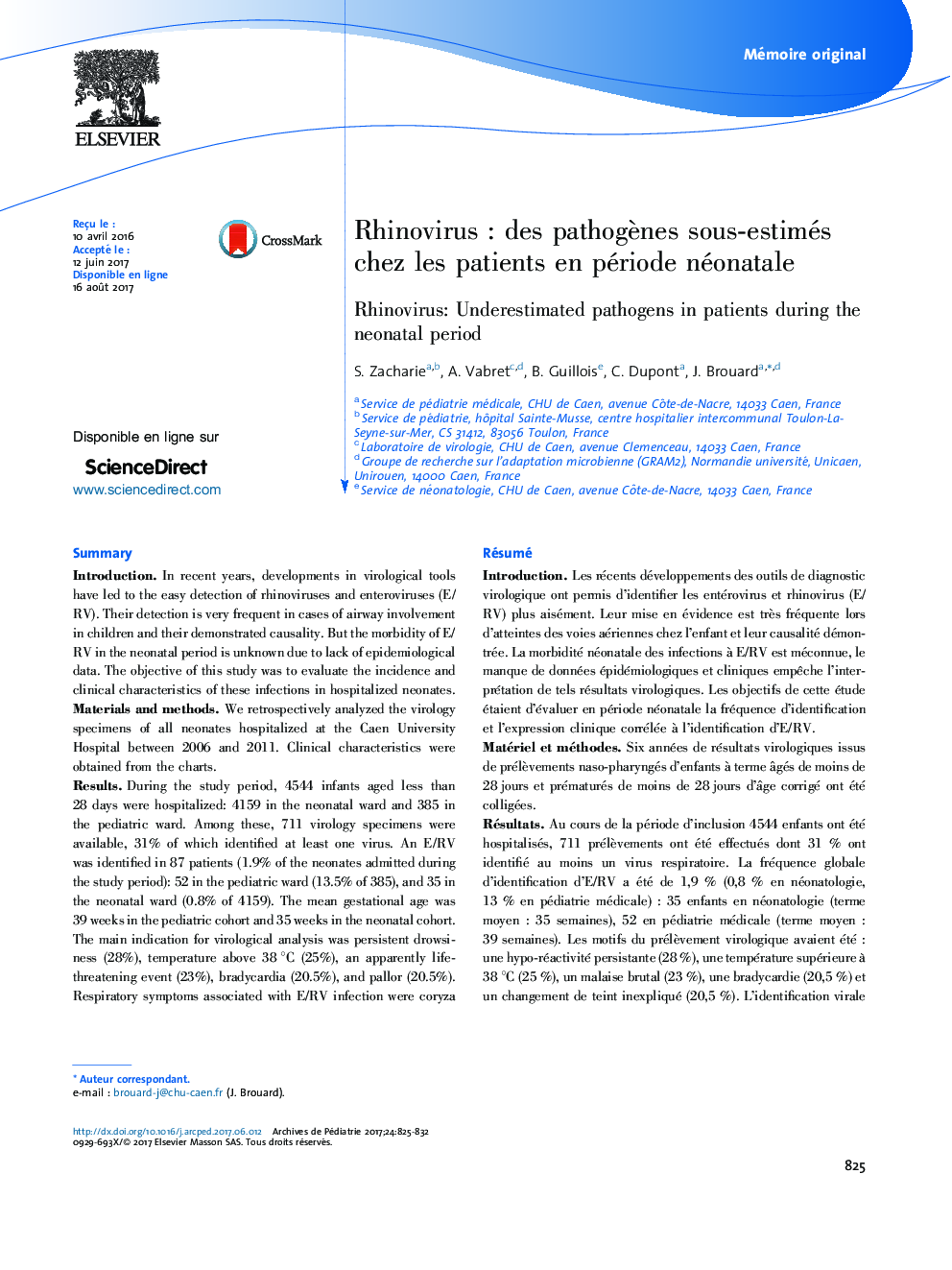| کد مقاله | کد نشریه | سال انتشار | مقاله انگلیسی | نسخه تمام متن |
|---|---|---|---|---|
| 5717370 | 1411198 | 2017 | 8 صفحه PDF | دانلود رایگان |

RésuméIntroductionLes récents développements des outils de diagnostic virologique ont permis d'identifier les entérovirus et rhinovirus (E/RV) plus aisément. Leur mise en évidence est très fréquente lors d'atteintes des voies aériennes chez l'enfant et leur causalité démontrée. La morbidité néonatale des infections à E/RV est méconnue, le manque de données épidémiologiques et cliniques empêche l'interprétation de tels résultats virologiques. Les objectifs de cette étude étaient d'évaluer en période néonatale la fréquence d'identification et l'expression clinique corrélée à l'identification d'E/RV.Matériel et méthodesSix années de résultats virologiques issus de prélèvements naso-pharyngés d'enfants à terme âgés de moins de 28 jours et prématurés de moins de 28 jours d'âge corrigé ont été colligées.RésultatsAu cours de la période d'inclusion 4544 enfants ont été hospitalisés, 711 prélèvements ont été effectués dont 31 % ont identifié au moins un virus respiratoire. La fréquence globale d'identification d'E/RV a été de 1,9 % (0,8 % en néonatologie, 13 % en pédiatrie médicale) : 35 enfants en néonatologie (terme moyen : 35 semaines), 52 en pédiatrie médicale (terme moyen : 39 semaines). Les motifs du prélèvement virologique avaient été : une hypo-réactivité persistante (28 %), une température supérieure à 38 °C (25 %), un malaise brutal (23 %), une bradycardie (20,5 %) et un changement de teint inexpliqué (20,5 %). L'identification virale positive avait été associée principalement à une symptomatologie respiratoire (rhinite : 74 %, toux : 35 %, désaturation : 32 %, tirage : 31 %) ou digestive (diminution des prises alimentaires : 59 %, régurgitations : 38 %, ballonnement abdominal : 24 %, vomissements en jet : 17 %). Une prise en charge en soin intensif néonatal ou en réanimation pédiatrique avait concerné 23 % de la cohorte. Une oxygénothérapie avait été nécessaire chez 24 % des enfants, une ventilation non invasive chez 11 % et une intubation trachéale chez 5 %. Une antibiothérapie avait été prescrite chez 36 des enfants (41 %) et une co-infection bactérienne avait été authentifiée chez 9 (10 %). Dans le service de néonatologie, une acquisition nosocomiale avait été suspectée chez 50 % des infections E/RV.ConclusionL'atteinte respiratoire haute bénigne par E/RV est classique, les infections néonatales à E/RV semblent pourtant corrélées à une morbidité marquée. Cette fréquence d'identification permet de souligner la sous-estimation de la transmission nosocomiale et l'importance de réévaluer les mesures de prévention dans ces secteurs. Nos résultats sont en faveur de la recherche des virus respiratoires, dont E/RV, lors d'une altération clinique inexpliquée en période néonatale ; une identification virale rapide serait susceptible de raccourcir une antibiothérapie souvent préemptive.
SummaryIntroductionIn recent years, developments in virological tools have led to the easy detection of rhinoviruses and enteroviruses (E/RV). Their detection is very frequent in cases of airway involvement in children and their demonstrated causality. But the morbidity of E/RV in the neonatal period is unknown due to lack of epidemiological data. The objective of this study was to evaluate the incidence and clinical characteristics of these infections in hospitalized neonates.Materials and methodsWe retrospectively analyzed the virology specimens of all neonates hospitalized at the Caen University Hospital between 2006 and 2011. Clinical characteristics were obtained from the charts.ResultsDuring the study period, 4544 infants aged less than 28 days were hospitalized: 4159 in the neonatal ward and 385 in the pediatric ward. Among these, 711 virology specimens were available, 31 % of which identified at least one virus. An E/RV was identified in 87 patients (1.9 % of the neonates admitted during the study period): 52 in the pediatric ward (13.5 % of 385), and 35 in the neonatal ward (0.8 % of 4159). The mean gestational age was 39 weeks in the pediatric cohort and 35 weeks in the neonatal cohort. The main indication for virological analysis was persistent drowsiness (28 %), temperature above 38 °C (25 %), an apparently life-threatening event (23 %), bradycardia (20.5 %), and pallor (20.5 %). Respiratory symptoms associated with E/RV infection were coryza (74 %), cough (35 %), hypoxemia (32 %), accessory muscle use, and recession (31 %). Digestive symptoms were poor feeding (59 %), regurgitation (38 %), abdominal distension (24 %), and projectile vomiting (17 %). Twenty-three percent of the patients required admission to the neonatal ICU or pediatric ICU. Respiratory treatments included oxygen (24 % of 87 patients), continuous positive airway pressure (11 %), and ventilation (5 %). Antibiotics were prescribed in 41 % of the patients (46), but only 10 % (9) had an identified concomitant bacterial infection. In the neonatal department, nosocomial acquisition was suspected in 50 % of E/RV infections.ConclusionE/RV infections have a significant morbidity in neonates, and nosocomial transmission of the virus is underestimated. We recommend that respiratory viruses, including E/RV, be tested for in any unexplained signs in a neonate. Better identification of viruses might shorten the duration of unnecessary antibiotics.
Journal: Archives de Pédiatrie - Volume 24, Issue 9, September 2017, Pages 825-832